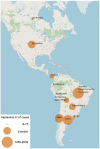Emergent Pneumonia in Children
- PMID: 34222146
- PMCID: PMC8247473
- DOI: 10.3389/fped.2021.676296
Emergent Pneumonia in Children
Abstract
In recent decades there have been multiple pathogens, viruses and bacteria, which have emerged as causal agents of pneumonia affecting adults, albeit less frequently, to children. For the purposes of this article we have classified emerging pathogens as follows: True emerging, to pathogens identified for the very first time affecting human population (SARS-CoV-1, SARS-CoV-2, MERS-CoV, avian influenza, and hantavirus); Re-emerging, to known pathogens which circulation was controlled once, but they have reappeared (measles, tuberculosis, antimicrobial resistant bacteria such as CA-MRSA, Mycoplasma pneumoniae, Acinetobacter baumannii, Pseudomonas aeruginosa, Stenotrophomonas maltophilia, and new serotypes of post-vaccine pneumococcal); and finally, those that we have called old known with new presentations, including common pathogens that, in particular condition, have changed their form of presentation (rhinovirus, and non-SARS coronavirus). We will review for each of them their epidemiology, forms of presentation, therapy, and prognosis in children compared to the adult with the aim of being able to recognize them to establish appropriate therapy, prognostics, and effective control measures.
Keywords: COVID - 19; children; emerging respiratory pathogens; pneumonia - clinical features and management; re-emerging respiratory pathogens.
Copyright © 2021 Perret, Le Corre and Castro-Rodriguez.
Conflict of interest statement
The authors declare that the research was conducted in the absence of any commercial or financial relationships that could be construed as a potential conflict of interest.
Figures




References
-
- Budnik I, Ferrés M, Pardo T, Edwards J, Labarca G, Reyes F, et al. . Contribution of molecular biology in the diagnosis of acute respiratory infections. Rev Chil Enferm Respir. (2016) 32:224–3. 10.4067/S0717-73482016000400003 - DOI
Publication types
LinkOut - more resources
Full Text Sources
Miscellaneous

